Fish farming can generate high interest and excitement. It has great potential to produce high quality protein in relatively short time periods and in small areas. Fish farming is one way that resource-poor farmers throughout the world can provide protein that is too expensive to purchase and is often lacking in the family diet.
This technical note is about raising tilapia in earthen ponds because tilapia are the second-most commonly raised fish in the world [carp are the most common] and are appropriate for resource-poor farmers in tropical areas.
This information is also aimed at people working in rural areas with resource-poor farmers in low income areas. Hopefully it can assist in planning and establishing fish farming projects.
The basics of fish farming are presented here, with recommendations and advice for establishing projects. Several case studies, stories, and examples from Africa are used as illustrations. References are given for more detailed information. There are many good “how to” manuals written on fish farming that can be accessed as additional resources (see “Usefel References” section at the end of this section).
Fish farming in a nutshell
Fish farming is the raising of fish in ponds, tanks, net enclosures, cages, or raceways. Usually the goal is to grow the fish as fast and economically as possible to a harvestable size. Some of the factors that farmers manipulate to influence growth rate include pond environment, type and density of fish, food, fertilizer, water quality, and growth period.
Fish farming is not new. People have raised fish for thousands of years. In some areas farmers are experienced and the techniques are quite developed; in others, fish farming is just beginning. In the past 30 years there has been a dramatic increase in fish farm production, especially in Asian countries (Figs 1 and 2).
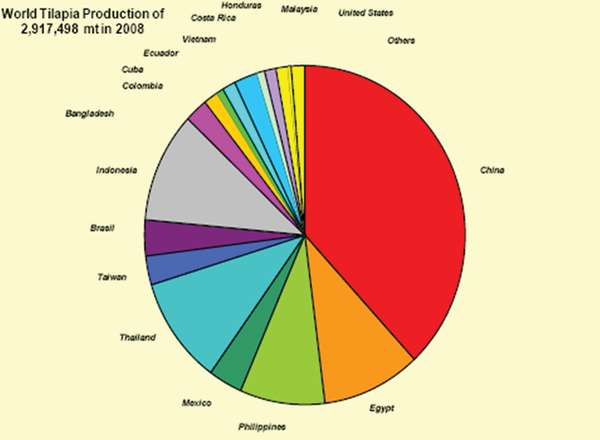
Figure 1. World Production of Tilapia. Source: Fitzsimmons and Naim (2010),
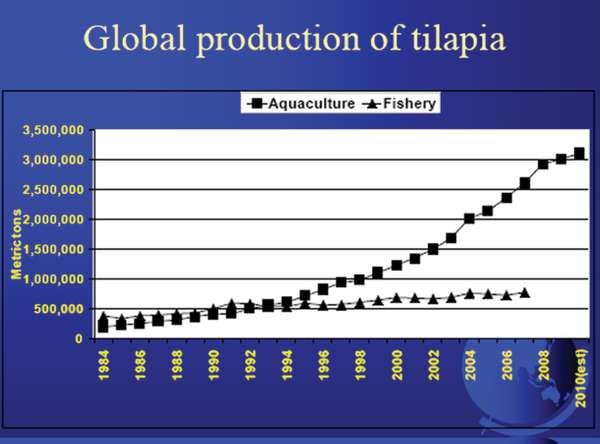
Figure 2. Annual Global Production of Tilapia by Aquaculture and Fisheries. Source:
Fitzsimmons and Naim (2010).
Part of the reason for this increase is the depletion of the natural fish stock and harvests from freshwater and ocean fisheries. A second reason is the increased promotion of fish farming as a means for low-income farmers to improve their nutrition and economic opportunities. Although the supply of fish decreases, the demand continues to increase. Fish farming is beginning to meet the deficiency in worldwide fish supply.
Tilapia
Tilapia is a commonly-raised fish throughout the world, second only to carp. According to Fitzsimmons and Naim (2010), in 2009 more than 3 million tonnes of tilapia were raised (Fig 5.29).
Tilapia thrive in warm tropical areas. They are a good fish for resource-poor farmers to grow because they are:
- Easy to raise
- Fast growing and tasty
- Able to eat many types of foods, and low on the food chain
- Highly disease resistant
- Able to reproduce easily
- Hardy and can tolerate poor water quality conditions
There are over 100 different species of tilapia, each with unique characteristics, behavior, and suitability to fish farming. A few of the most commonly farmed are the Nile tilapia (Oreochromis niloticus), blue tilapia (O. aureus), Mozambique tilapia (O. mossambicus), redbelly tilapia (Tilapia zillii), and the red breasted tilapia (T. rendalli). A good description of each species can be found in Balarin (1979) and Bocek (N.D.).
Ponds
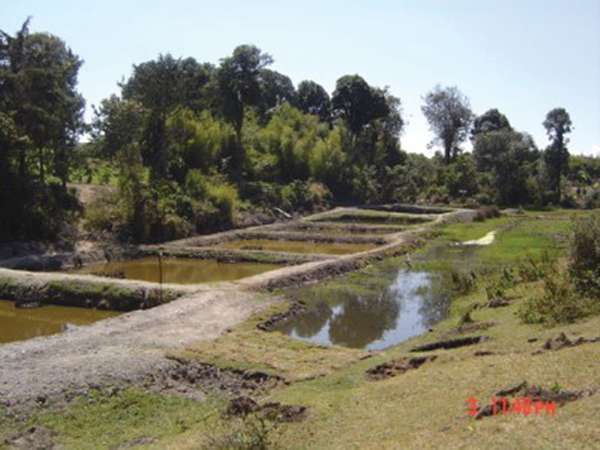
Figure 3. A series of earthen ponds which allow independent draining and filling.
Tilapia can be raised in earthen ponds, cement raceways and tanks, cages and enclosures. The scope of this section is on earthen ponds because they are most common, least expensive, and usually carry the least risk, making them appropriate for resource-poor farmers.
Constructing an earthen pond is labor intensive when using shovels, picks, and hoes. This is the way that most farmers in tropical countries build their ponds. The time required to build a pond varies according to the pond design, specific conditions, and the number of people building it. Typically a 10 x 15 m pond can be completed in 3-4 weeks. It costs the farmers little besides time and labor. However, a pond can be used for many years when properly constructed and maintained.
Site Selection Parameters
Selecting an appropriate site is important before starting to build ponds. Consideration needs to be given to water supply, soil type, topography, and location.
- Water. A reliable water source during the growing season of the fish is needed. Water can come from springs, runoff, rivers, or ground water. Water contaminated from pollutants is not suitable, since it can cause health problems for both fish and humans.
- Soil. Soil containing greater than 10%-15% clay is desirable for retaining water in ponds and preventing seepage. Avoid sandy soils because these allow high rates of seepage.
- Climate. Tilapia thrive in warm water of 25°C-30°C, usually found in tropical areas at low elevation. Fish growth and reproduction are slower at cooler temperatures. Ponds should be located in full sunlight to receive maximum solar heating and plankton growth.
- Topography. Gently sloping topography is ideal for fish ponds because it allows for drainability. Ponds can be built in flat or hilly areas, but construction can be more difficult. Avoid low areas where ponds cannot be drained or are susceptible to flooding or damage during heavy rains.
- Location. The optimal location for a pond is near the owner’s house, making it easier to manage and to protect from theft and predators.
Pond Design and Construction
Although building a pond may seem simple, there is a right and wrong way to build one. An improperly built pond can leak, have a weakened dam susceptible to breakage, and potentially present many other problems. Considering that a pond can be used for many years, take the time and effort to build it properly.
Rectangular ponds are easier to build than square or irregularly-shaped ponds. Ponds should be built so that each one can be filled and drained independently from other ponds (Figs 3 and 4). Total drainage is advantageous to prevent stunting and disease.

Figure 4. Example of a good vs. poor pond layout.
Source: Murnyak and Murnyak (1990).
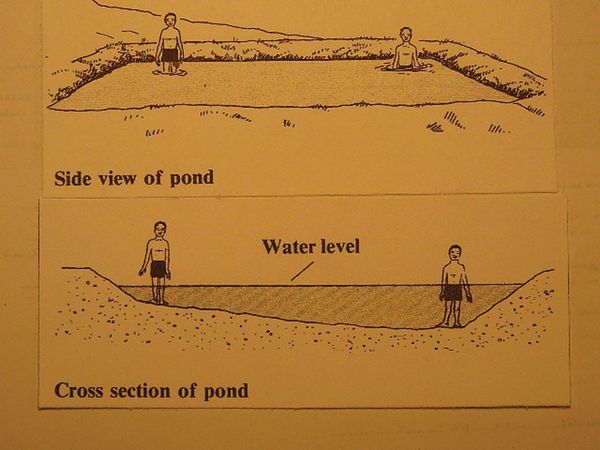
Figure 5. Side and cross section view of ponds showing
desirable depth. Source: Murnyak and Murnyak (1990).
A series of ponds (200-300 m2 each) are preferable to one large pond. This way, farmers can stagger the timing of stocking and harvesting of different ponds, allowing for a year-round supply of fish.

Figure 6. Farmer measuring slope of pond
walls. Source: Murnyak and Murnyakk (1990).
The preferred depth for tilapia ponds is at least 1 m (4 ft or waist deep) in the deep end and 30 cm in the shallow end. The pond bottom should be sloped to allow total drainage (Fig 5). Deeper ponds, which would have more of a water reserve, may be useful in areas of unreliable water availability.
There are many books written on how to build ponds. Refer to the “Useful References” section for examples. Some of the more important points to keep in mind during construction are:
- Build a core trench in dams
- Compact soil regularly when constructing pond dams.
- Slope pond walls at least 2:1 (Fig 6).
- Slope pond bottom (Fig 5).
- Do not put rocks, sticks, or organic matter in dam.
- Make top of dam at least 30 cm above pond water level.
- Install a screened inlet and outlet to prevent wild fish from entering and tilapia from escaping.
Pond management
Building the pond is hard work that lasts a relatively short time. Managing the pond is easier but lasts as long as the fish are raised. A well-managed, poorly constructed pond can be productive, but a poorly-managed, well-constructed pond will not be productive. Good management is the key to successfully raising fish. Stress good pond management with farmers. They need to hear this message loud and clear, and repeatedly. Sometimes people think that because fish can fend for themselves in the wild, they should be able to do so on their own in a pond also. Not so! Only with good management can the pond provide farmers with satisfactory harvests. Again, stressing that good management means good results is a good idea.
New farmers should be monitored frequently during pond construction and up to their first harvest. This is to encourage and advise farmers in the early stages. Pond interest is often in proportion to the frequency of project visits by extension and project staff. Usually the greater the interest, the better the management will be. The opposite is true with infrequent visits.
Frequency of extension visits effecting results in fish farming(↓) frequency of extension visits → (↓) interest in fish farming → (↓) pond management → (↓) pond production → discouragement → abandonment of pond |
Stocking
Once a pond is completed and meets project standards, stock it with fish as soon as possible. A filled pond without fish is a breeding area for mosquitoes. Furthermore, it discourages farmers to have to wait long for stocking.
Recommended stocking rates are between one to three fingerlings per square meter of pond surface area. Choose good quality, pure strains of fingerlings 5-7 cm in length. A highly recommended species is Nile tilapia. Avoid stunted or mixed species of fish. Get advice on locations of reliable sources of fish stock.
Tilapia reproduce easily and quickly. Once a project is established, project farmers can supply fish for stocking new ponds and for restocking existing ponds. Farmers practicing good pond management should be the preferred source. Select farmers can be advised to start small village hatcheries to assure a good supply of quality fingerlings for stocking. Farmers starting village hatcheries need additional specialized training (refer to the “Village Hatcheries” content following).
Fertilizing and feeding

Figure 7. Feeding time!
Fish, like all animals, need food to grow. Farmers can provide food for tilapia in two ways: by supplemental feeding and by fertilizing the water. It is most productive to use both methods. Food in the form of plankton can be stimulated to grow by adding manure and compost to the pond. [Ed: See section 5.3.2 for more detail.] It is an inexpensive method of feeding, and plankton is necessary for the smaller fish which are too small to eat supplemental feeds. Pond water will turn a rich green or reddish color when the plankton becomes abundant. This means that food will be available for the fish. Clear ponds are not fertile and lack plankton.
The other way to feed fish is to provide supplemental feed directly into the pond. Tilapia can eat many types of feed. Some common feeds are rice bran, mill sweepings, termites, table scraps, maize bran, and many green leaves. Feed the fish twice a day, giving them only the amount that they will consume in a couple of hours. Excess feed in the pond leads to feed spoilage and fouling of the water, which can result in oxygen reduction and fish kills.
Pond Maintenance
Advise farmers to visit their ponds each day to feed their fish and to check on the fish and pond. The following are some of the tasks to perform as needed:
- Clean inlet and outlet of debris which can clog up and prevent movement of water.
- Replenish water to maintain desired level.
- Observe fish to confirm that they are behaving normally.
- Look for signs of predation and theft such as footprints, scat, muddy water, etc.
- Look for seepage or dam damage.
- Remove weeds from pond.
- Cut grass on pond banks.
- Add manure or compost to compost fences.
Harvesting

Figure 8. Seining a pond during final harvest.
Tilapia can grow quickly in well-managed ponds. Farmers can begin to harvest some fish 3-4 months after stocking. They can do this by conducting partial harvests with nets (Fig 5.34), hook and line, or traps, each time keeping the larger fish and returning the smaller ones to the pond. Partial harvests can be done every week or two. It is encouraging for farmers to see the growth of their fish and to be able to eat some.
After 6-12 months (depending on the climate), it is crucial to conduct a final harvest in which the water is drained from the pond, all the fish are harvested, and the pond is dried out for 2 weeks. Drying out the pond will kill fish fry (small young fish) and eggs and prevent overpopulation, which leads to stunting. Farmers then refill the pond and restock following the recommended stocking rate.
During harvest, fingerlings for restocking can be moved to a small holding pond while the pond is harvested, drained, and dried. Another option for restocking is to capture fingerlings from another pond.
Production
In warm areas and under good management conditions, farmers can expect to produce between 30 and 50 kg of fish per 100 m2 every 6 months (Table 1). This means a family having six 200-m2 ponds can produce between 720-1200 kg of fish annually. This can have a significant impact on the family’s diet, health, and income.
|
Table 1: Expected production level of tilapia in cool and warm areas. |
|
|
Warm and low elevation areas |
Cool and high elevation areas |
|
60-100 kg/100 m2/year |
30-60 kg/100 m2/year |
Village hatcheries

Figure 9. Farmers select good quality
breeding stock.
Good quality fish stock is an important factor in achieving high production. Farmers raising tilapia in village projects obtain fingerlings for stocking from other farmers’ or their own ponds. Over time, this can result in an inferior quality of fish stock, because farmers generally harvest the larger fish to eat and sell and return the smaller fish to give them a chance to grow bigger. This gives the smaller and slower-growing fish greater opportunity to breed than the larger and faster-growing ones. Unintentionally they are selecting inferior stock.
Other problems associated with obtaining stock from farmers’ ponds are the possibilities of stunting, inbreeding, and mixed species—if farmers are not managing the ponds well and not draining and drying the pond regularly.
Using poor-quality fish stock will hinder fish growth and production. It is advisable to obtain high-quality stock from reliable farmers or from government-run or private hatcheries. However, it is often difficult and expensive for village farmers to purchase and transport fingerlings from hatcheries, especially if located far from their ponds.
One way to avoid these problems is to encourage and train farmers to start up and operate small village hatcheries (Fig 9). They can provide good quality fingerlings for stocking by having several breeding ponds and nursery ponds. They select fast-growing and larger fish (usually 100-200 g in weight) for breeding. These are stocked in a breeding pond at a male to female ratio of 1:5. After breeding and producing fry, the brooders are separated from the offspring. The fry are moved to nursery ponds to grow until they reach stocking size and can be sold.
Refer to Nandlal and Pickerling (2004) for more information on hatchery management.
Lessons learned
Too often, development initiatives or projects that appear successful in the early stages stop after the outside project leadership phases out. Fish farming projects are not exempt from this fate. Lessons learned from failed projects can improve the possibility of project sustainability. Project sustainability here refers to the continuation of the activity (fish farming) and not necessarily of the development project. Some of these lessons are as follows:
Keep it simple
Strive to keep the project and technologies simple, inexpensive, and replicable with as little dependence on outside assistance as possible. Use local materials and resources, and select fish species that are easy to grow. This can result in lower production, but the risk to farmers will be less and the technology will be more applicable.
Development workers are often attracted to more sophisticated technologies and resources as they strive for maximum production. Keep in mind that higher production often comes with greater risks and investment, less widespread participation by resource-poor farmers, and lower sustainability.
Promote self-reliance
The focus of projects should be on what farmers can do, not what the project can do for them. Be cautious about offering assistance until all local resources and initiatives are tried and prove to fall short. Ask not “how can I help?” but “how can you, the farmers, do this?”
This approach will nurture self-reliance and a “can-do attitude,” and will avoid the dependency syndrome that is all too common in development projects. Make clear from the start that projects provide only technical assistance and whatever resources are missing (e.g., fish stock) but not handouts. Although difficult, setting the tone early on will pay off in greater self-reliance later.
Encourage realistic expectations
Before practicing fish farming, farmers may have unrealistic expectations of the results (i.e., profitability and productivity) they can achieve raising fish. During introductory meetings and discussions with interested farmers, provide accurate information on the amount of work, capital, and resources needed. Let them know what to expect in terms of profitability, productivity, and common problems to be faced. Unrealistic expectations can lead to disappointment for farmers and loss of interest in the activity.
Seek participation at all levels
The greater and wider the participation the better. As in all activities in our lives, the more invested we are in something—our time, money, enthusiasm, and hope—the harder we work at it. So it is with fish farming projects.
Strive for project participation on as many levels as possible: families, community, local government and religious leaders, community workers, government staff, etc. The more stakeholders that are invested in the project, the better.
Avoid having farmers raise fish in isolation. It is better to have farmer groups that can raise their fish individually but work together on pond construction, harvesting, marketing, purchasing supplies, exchanging of ideas, securing loans, and lobbying.
Promote training and capacity-building
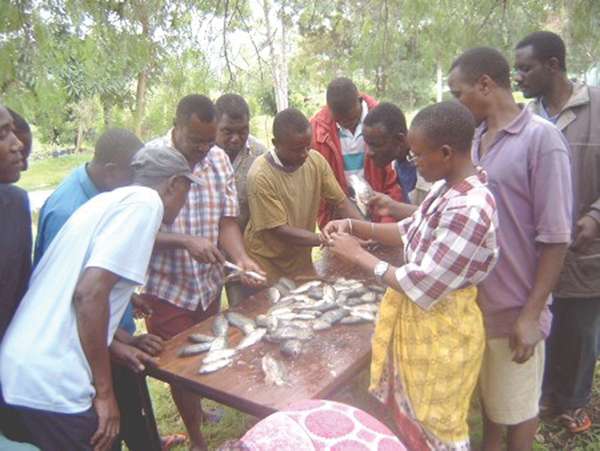
Figure 10. Trainees learning to measure and weigh fish.
I cannot resist mentioning the over-used Chinese proverb, because it is so relevant and profound in this situation: “If you give people fish, they will have food for a day. If you teach them how to fish, they will have food for their lifetime.”
Build capacity, build capacity, and build more capacity—and yet it will probably still not be enough. Teach farmers all they need to know about fish farming; train select farmers to train others; train farmers in hatchery management; train farmer groups in management and leadership; train community leaders how to support farmers; train extension workers in fish farming when they lack some of the technical and extension skills; and train project staff.
This type of capacity building requires money and time, but it is worth the investment. It improves the chance of project sustainability and success. Investment in people and skills will have a spill-over effect into other projects.
Remember that small is beautiful
E.F. Schumacher wrote a book entitled Small is Beautiful, and indeed it is with development projects. Keep projects on a scale that is manageable so that quality can be maintained. When good results are achieved in a project, the tendency is to expand (geographically, numerically, and in the scope of activity). If expanded too quickly, the project can be diluted, leading to disappointing results. Take it slow but steady, being careful not to exceed the capacity of the project. Keep the focus on core activities and improve on these.
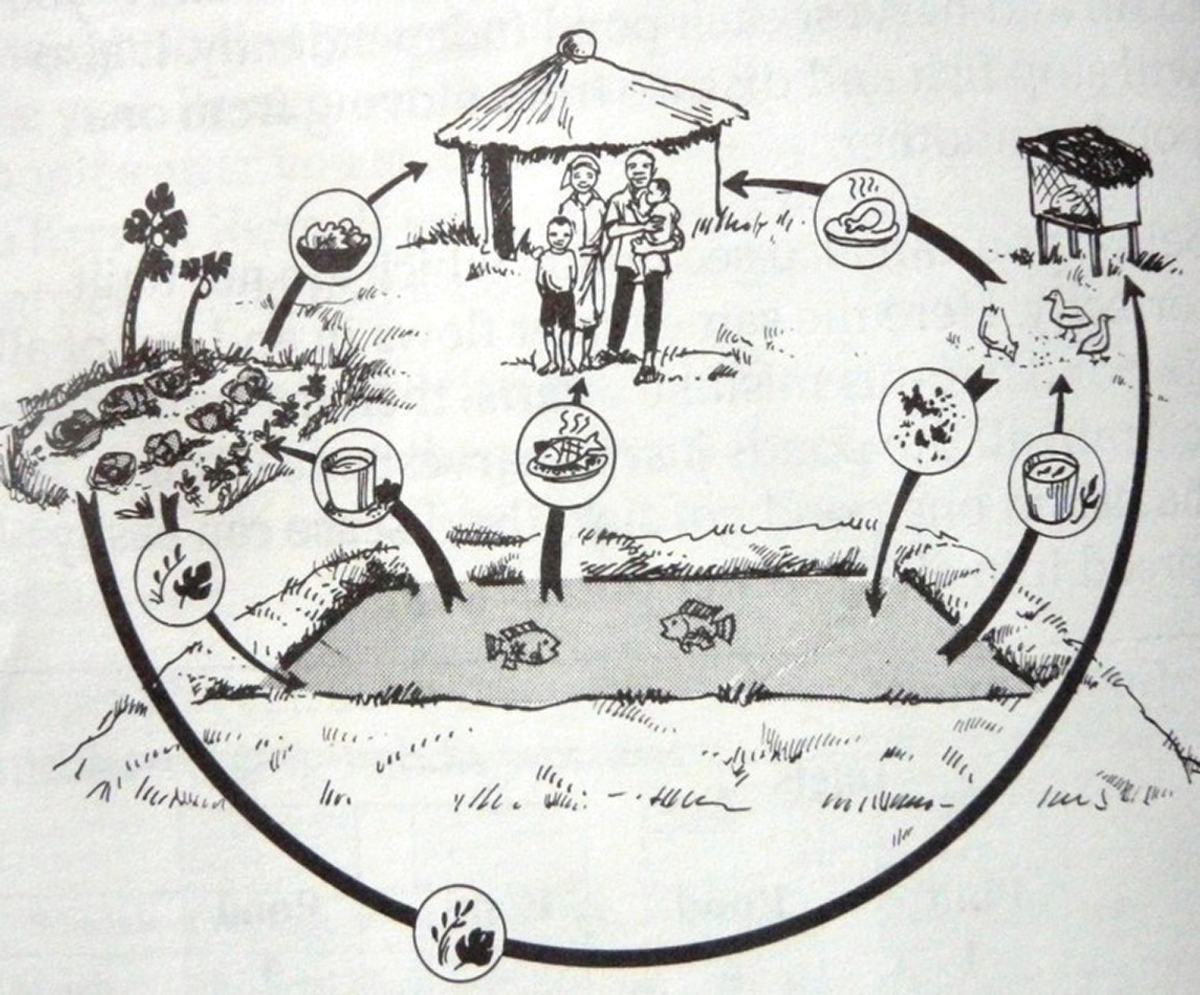
Figure 11. Diagram of cycling of resources in integrated fish farming system.
Source: Murnyak and Murnyak (1990).
Integrate
Fish farming works well when integrated within a farming system. Encourage farmers to combine it with vegetable gardening, growing rice, animal husbandry, orchards, etc. This way, resources and nutrients are cycled within the system in a mutually beneficial way. Also, in this way, risks are lessened (Fig 5.36).
Spread the idea and the technology
When early fish farmers in a community are successful in raising fish, others are often attracted and want to begin. Without some technical assistance, they will achieve mixed results. Although raising tilapia is simple, it does require some knowledge and skills. We have found the following methods most effective in spreading the idea:
- farmer-to-farmer exchange and discussions
- field trips to visit project farmers
- volunteer motivator system (VMS)
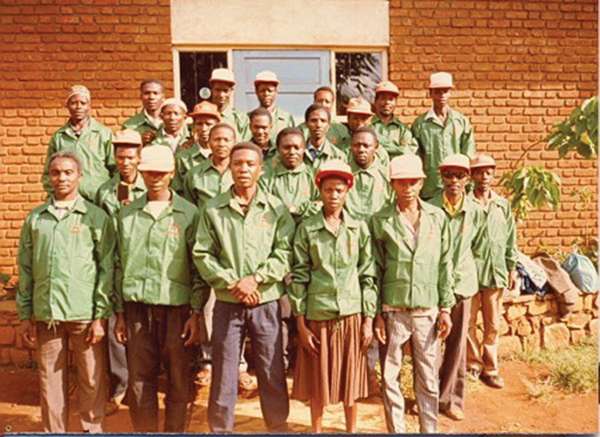
Figure 12. Group of fish farming motivators.
VMS is a system in which project farmers promote fish farming and provide basic extension support in their communities and in new areas. Project farmers are selected by their communities and receive additional training in fish farming and extension methods. They promote fish farming, provide extension support, and report on project activities. They usually work with about 10 farmers each. Their dedication and enthusiasm can be remarkable.
The following are some of the advantages of using VMS in fish farming projects:
- VMS enables wide coverage at low cost.
- Motivators are local, knowing culture, language, and the people.
- Motivators are volunteers and therefore not dependant on outside “project” funding.
- Knowledge and skills are in the hands of the local population.
Testimonial: Pastor Urasa attended a fish farming training course that I conducted at the Integrated Agriculture Training Center at Dareda. A humble, yet very intelligent Lutheran pastor, Pastor Urasa came from northern Tanzania to learn about fish farming so he could help promote it in his diocese.
During the two-week training, he worked hard to understand the basics of fish farming. He listened intently and studied hard. It was unusual to see such a well-dressed and dignified person so ready to roll up his pant legs and shirtsleeves and get into the work at the bottom of a muddy fish pond. He fully participated in all the practical fieldwork of the course. Pastor Urasa added a greater spiritual dimension to the course by his leading in morning and evening devotions. The participants seemed to greatly appreciate his messages.
When he left the course, he was excited about the possibility of fish farming in his diocese. I wasn’t sure what would come of it, though. Would he get back into his traditional church work and the many demands of his parish and forget what he had learned about fish farming? I learned the answer 6 weeks later when he came to see me at my office. He handed me a list of 15 farmers who had dug ponds following his instructions and had already paid money for fish for stocking. They were waiting for me to bring fish to stock their ponds.
They were the first people to have built ponds in that village. Pastor Urasa’s name was on the list also. After he returned from the course, he told the farmers what he had seen and learned at the center. He convinced them to try fish farming. He taught them how to build a pond, and he supervised the work in addition to building his own. There were 15 ponds ready and waiting to be stocked with fish. He wanted me to give him a date that I could come with the fish.
Two weeks later, I went to Pastor’s Urasa’s village with enough fish to stock the ponds. We went from pond to pond, stocking the fish. Each pond was well constructed and the farmers eager to start raising fish. By the end of the day I started to notice some people with buckets following us from pond to pond. When we got to the last pond and stocked it with the remaining fish, they stood around as if waiting for something. I asked Pastor Urasa who they were. He pulled a piece of paper out of his pocket and handed it to me. It was a list of another 20 farmers who had built ponds in the 2 weeks since he had come to my office.
He said they were here with their buckets in the hope of getting fish to stock their ponds also. When he told them there was not enough fish for their ponds that day, they were disappointed. I promised them I would bring more fish another day. That day showed me just how eager and excited farmers in Tanzania can get about fish farming when they have confidence that someone like Pastor Urasa will assist them. Having built his own pond, the people had even more confidence in what he was telling them.
The farmers in that area went on to do an excellent job of pond management and raising their fish. I was surprised to see how fast the fish grew and reproduced in that area. Pastor Urasa was encouraging them to feed their fish each day and to put fertilizer in the ponds. He had learned his lessons from the training well.
Maintain project standards
Start with and adhere to approved project standards of fish farming—especially pond construction, management, and regular harvesting/drying of the ponds. Do not agree to stock fish in poorly-constructed or incomplete ponds; it is better to wait until all work is completed and project standards are met. Refer to checklist below for a list of tasks to be accomplished before stocking ponds.
Quality Control Checklist for Pond Stocking:
|
More details regarding pond management and fish production are summarized in Table 2.
|
Table 2: Recommended guidelines for fish farming projects. |
|
|
Parameter |
Guideline |
|
Pond size |
minimum 100 m2; average 200 m2 |
|
Pond depth |
shallow end 30 cm; deep end 1 m |
|
Number of compost fences per 100 m2 |
2 |
|
Number of ponds per family |
4-6 |
|
Preferred species |
Nile tilapia |
|
Stocking rate |
1-3 fingerlings (5-7 cm) per m2 of surface area |
|
Frequency of feeding |
twice per day |
|
Amount of feed |
amount that fish will consume in a couple of hours |
|
Frequency of fertilizing |
enough to keep water green or reddish in color |
|
Frequency of final harvest |
at least annually |
|
Time for pond draining after final harvest (before restocking) |
two weeks |
|
Frequency of adding new water to pond |
only needed to maintain water level |
|
Frequency of extension visits to new farmers |
at least once every two weeks |
|
Ratio of motivators to farmers |
not to exceed 1:10 |
Problems encountered
Raising tilapia in earthen ponds can be relatively simple, but sometimes problems are encountered. Before they start, farmers should be made aware of likely problems and understand ways to prevent and solve them when encountered. Farmers are very innovative and find new and creative solutions to such problems. Table 3 lists the more commonly encountered problems in fish farming and suggests preventions and solutions.
|
Table 3: Common fish-farming problems and possible prevention interventions and solutions. |
|
|
Problem |
Prevention/Solution |
|
Theft |
build pond near house frequent pond visits build fence or hedge around pond place sticks in pond to hinder netting |
|
Birds |
keep pond fertile (green color) scare off or kill |
|
Otters |
hedge or fence pond trap place sticks in pond to slow otters |
|
Snakes |
keep grasses on banks short and clear of brush |
|
Wild fish |
screen inlets and outlets remove by netting |
|
Frogs |
remove by nets remove tadpoles and eggs raise ducks in pond |
|
Stunted fish |
follow stocking rate good pond management drain pond and dry at least annually |
|
Pond seepage |
proper pond site selection and construction fill holes caused by termites, moles, etc. add manure and compost to pond bottom and compact soil continue to replenish water until mud seal is formed and seepage slows |
|
Fish kills |
avoid sudden and large water temperature changes avoid low oxygen levels by not overstocking or using excess feeds and manure add new water when dead fish are observed in pond |
|
Water shortage |
select sites with reliable water source in areas with seasonal water availability, plan to use ponds only during times when water is available (usually 4-6 months is adequate); these are seasonal ponds |
|
Health hazards: Malaria Schistosomiasis (Bilharzia) |
malaria not a problem when ponds are kept free of weeds and stocked with fish; tilapia eat mosquito larvae remove snails from pond make pond banks steep keep catfish and ducks in pond; they eat snails make sure no one urinates near or in pond |
Case studies
Farmers in Zaire (a story illustrating breeding habits of tilapia)
The farmers I worked with in Zaire were not experienced in raising fish. They had only recently built their ponds and started raising tilapia. I tried to teach them some of the basics of fish farming whenever I visited them at their farms, and got to know them very well. They were my friends, and they had confidence and trust in me. There was only one lesson they couldn’t accept. Several times I explained to them about how tilapia care for their eggs and young. They are mouth brooders. The male makes a nest in the mud on the pond bottom, using his tail to form a bowl-like depression. He tries to attract a female to his nest. If successful, a female will come and lay her eggs in the nest. The male fertilizes them. The female then picks up the eggs in her mouth and incubates them for several weeks. During this time she eats very little.
As the eggs develop into fry, the mother keeps them in her mouth. Only when they are strong and big enough to swim does she release them into the water. They will stay close to the mother. The school of small fry looks like a dark cloud around her. They retreat back into her mouth when threatened by frogs, fish, or insects. It only takes a wink of the eye for the 100 to 300 fry to quickly swim back into the mother’s mouth.
The farmers would listen patiently as I explained the mouth breeding habits of tilapia. When I finished, they would laugh and make it obvious that they did not believe a word of it.
One day we were sampling one of their ponds, something I liked to do every couple of months so the farmers could see how their fish were growing. It is hard to see the fish clearly in the green-colored water. If they could sample and weigh the fish, they would be encouraged to continue to feed the fish and fertilize the pond. We used a small seine to capture enough fish to get a representative sample to compare the growth from the previous time of sampling. They captured about a dozen fish and put them into a bucket with water. As they were making another sweep with the net, I noticed a bunch of small fry in the bucket. One of the fish must have been protecting the fry in her mouth when she was caught in the net and then spit them out after being placed in the bucket.
I thought, “Finally I have a chance to get these guys to believe me about the mouth brooding habits of tilapia.” I excitedly called them to gather around and see the tilapia fry in the bucket. They did and then one asked me, “What is the big deal?” I replied that this shows what I was trying to explain to them all along. The mother had the fry in her mouth and let them out after being put in the bucket. He said, “No way, Dennis. The fry probably got into the bucket when filling it with water from the pond. We just didn’t notice them until now.”
I was getting too close to give up yet. I told them that I would put my hand in the bucket to scare the mother and fry, and asked them to watch closely as the fry would swim back into the mother’s mouth. I did, and the fry did just as I predicted. The farmers gasped in amazement. They were quiet for a few moments until one said, “Wow! Did you see how fast that fish ate up all those fry?”
I was feeling frustrated and about ready to give up. I thought, “Let me give it one more try.” I put the bucket off to the side and told the farmers to leave them alone. If the fish settled down, the mother might release the fry from her mouth. Sure enough, when I looked in the bucket after a short while, the fry were swimming around. I called the farmers and told them to approach slowly to have a look. Finally, they believed what I told them about the mouth brooding habits of the tilapia.
Lucas’ catfish (illustrating the importance of knowledge and training)
Fish farming was not a completely new idea to Tanzania. It was introduced to countries in Africa during the 1950s and 1960s by the colonial governments. The intentions were good, in that fish could be a good source of protein for the people. However, the methods that were used were often counterproductive. In some cases, it was actually enforced, and villagers could be fined if they didn’t build ponds and raise fish. In Zaire, I was told stories of how villagers built small shallow ponds to avoid the fines and waited for the extension officers to bring fish to the village for stocking. Some villagers would collect the fish and go straight to their homes and cook them for dinner!
In Tanzania it was not enforced but often fish farming was promoted without the necessary technical support and training. In addition, inappropriate fish species were often distributed. These fish did not perform well, resulting in stunting, poor pond production, and discouraged fish farmers.
One of the first people in Tanzania to contact us for assistance in fish farming was Lucas. He lived in a nearby village from us. We went to visit him and see his pond. He told us that he had heard about fish farming on the radio and built a pond several years ago. He went to a lake about 25 km away and bought three live catfish from a fisherman. That was all he was able to buy that day, but he was sure that would be enough and that they would soon reproduce. He put them in a bucket with water and took a bus home. He then carried the bucket on his head to his pond, about a mile from the road, and stocked the fish in his pond.
For 2 years he took care of his fish, feeding them each day. He occasionally saw them in the water and could see that they were growing. He was not sure if they reproduced because he hadn’t seen any small ones. We advised him to drain the pond and harvest the catfish and then stock with another type of fish known as tilapia that would be more productive and better for him. Lucas agreed and dug an opening in the pond wall and drained the water out. He harvested three very large catfish, but that was all. They never reproduced during the 2 years. Lucas was quite disappointed, as he thought of all the feed and time he put into the pond and all he had to show was three fish. What Lucas did not know was that the African catfish do not usually reproduce in small farm ponds.
This was the situation we faced when we started promoting fish farming in Tanzania. Farmers were very much interested and were willing to put in great efforts, but they knew little about it and had little experience. We took it slow and worked with about 10 farmers scattered in five villages the first 6 months. We taught them how to build ponds and how to raise fish under more and better pond management.
Mrs. Anderson (example of an effective change agent)
I was invited by the village of Kikwe, 15 miles from Arusha, to help them get started in fish farming. We held an introductory meeting that 25 people attended. I explained the basics and benefits of fish farming. When I asked how many were still interested in getting involved with the project, all 25 raised their hands. We set a date to visit some farmers in another village who were already practicing fish farming. Fifteen people showed up for the field trip.
I returned another day to visit potential pond sites. Ten people showed up. We staked out their ponds, and I explained how to get started digging them. I returned yet another day to find that, of these, five farmers had started digging. Of the five, only one finished her pond—Mrs. Anderson. We went from 25 participants to 15 to 10 to 5, and were left with only one after a process that took 3 months.
Mrs. Anderson was a strong woman. She was 35 years old, had five children and was a committed Christian. What struck me about her was the contrast between her face and hands. She had sparkling eyes, always smiling, and a gentle voice. This was in contrast to her rough and calloused hands. Her hands showed the hard work she had done and the hard life she had lived.
It was with those hands that she grasped a shovel and dug at the hard soil to start her pond. There is no easy way to dig a fish pond by hand, using a shovel and a hoe. It takes hard work and guts. It has been estimated to take 50,000 shovelsful of dirt to dig a 30 x 50 ft pond. It is a physical and mental marathon. If you go too fast, you can wear yourself out. If you dig too slowly, you will never finish. If you think too much, you will become discouraged. You have to pace yourself. Mrs. Anderson had the patience and stamina. She also had hope—a hope that the result would be worth the effort. The other 24 farmers lacked this and were not able to go the distance.
Mrs. Anderson, with her children, worked on her pond each day for 1 month. She b uilt the first pond in Kikwe. She was proud and happy when she stood on the pond bank and watched the 300 small 2 in long fingerling fish that she had just stocked into the pond.
She took good care of her fish, and liked to show her fish and pond to her neighbors. They could see how fast the fish grew. Mrs. Anderson would encourage them to also build ponds, but no one did. They were too cautious. Six months later, she harvested some of her fish and cleaned and cooked them. She invited some of her neighbors to a meal of fresh fish. She felt if they tasted the fish they also would build ponds.
It worked! With help from Mrs. Anderson, 30 other farmers built ponds and started to raise fish in the village of Kikwe!
Useful references
Balarin, J. 1979. Tilapia: A Guide to Their Biology and Culture in Africa. University of Sterling.
Bocek, A. Editor. Water Harvesting and Aquaculture Development Series. International Center for Aquaculture and Aquatic Environments. Auburn University.
Chakroff, M. 1976. Freshwater Fish Pond Culture and Mangaement. Peace Corps/Vita 191 pp.
Equia, R.V. and M.R.R. Equia. 2007. Tilapia Broodstock and Hatchery Management. 48 pp.
Frtitzsimmons, K. and S.Naim. 2010. Tilapia: 2009 State of the Industry. Tilapia Session. San Diego-WAS-March 5, 2010.
FAO. 1979. How to Begin. Series #27. Better Freshwater Fish Farming. 43 pp.
FAO. 1981. The Pond. Series #29. Better Freshwater Fish Farming. 43 pp.
FAO. 1981. The Fish. Series #30. Better Freshwater Fish Farming. 48 pp.
Marr, A., M.A.E. Mortimer, and I. Van Der Lingen. 1966. Fish Culture in Central East Africa. 158 pp.
Murnyak, D. and M. Murnyak, 1986. Fish Farming Development in Tanzania. Heifer Project International Exchange. #3 May, 1986. p.1.
Murnyak, D. and M. Murnyak. 1990. Raising Fish in Ponds: A Farmer’s Guide to Tilapia Culture. Heifer Project International. Little Rock , Arkansas, USA. 75 pp.
Murnyak, D. and M. Murnyak. 2000. The Role of Volunteer Motivators in Development. Footsteps 43:2-5.
Nandlal, S. and T. Pickerling. 2004. Tilapia Hatchery Operations. Tilapia Fish Farming in Pacific Island Countries. Vol.1. Noumea, New Caledonia: Secretariat of the Pacific Community.
Schumacher, E.F. 1973. Small is Beautiful: Economics as if People Mattered. 286 pp.